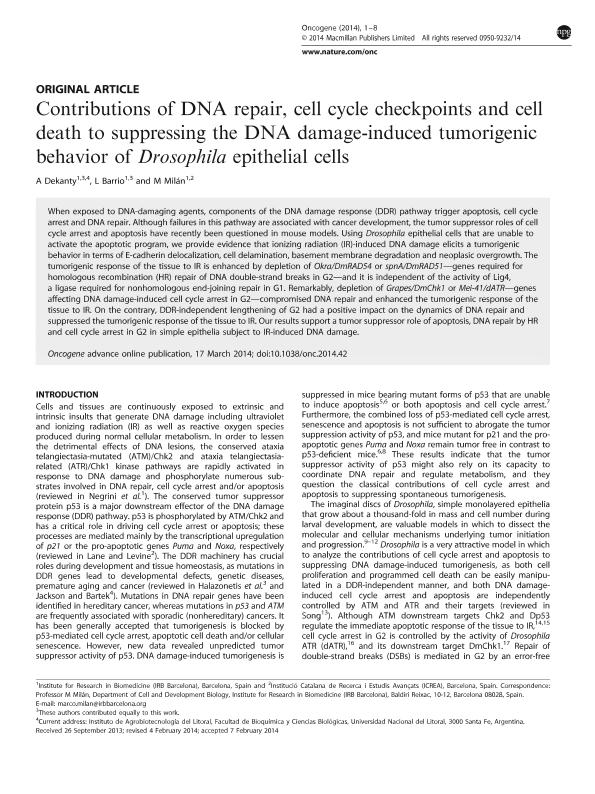Artículo
Contributions of DNA repair, cell cycle checkpoints and cell death to suppressing the DNA damage-induced tumorigenic behavior of Drosophila epithelial cells
Fecha de publicación:
02/2015
Editorial:
Nature Publishing Group
Revista:
Oncogene
ISSN:
0950-9232
Idioma:
Inglés
Tipo de recurso:
Artículo publicado
Clasificación temática:
Resumen
When exposed to DNA-damaging agents, components of the DNA damage response (DDR) pathway trigger apoptosis, cell cycle arrest and DNA repair. Although failures in this pathway are associated with cancer development, the tumor suppressor roles of cell cycle arrest and apoptosis have recently been questioned in mouse models. Using Drosophila epithelial cells that are unable to activate the apoptotic program, we provide evidence that ionizing radiation (IR)-induced DNA damage elicits a tumorigenic behavior in terms of E-cadherin delocalization, cell delamination, basement membrane degradation and neoplasic overgrowth. The tumorigenic response of the tissue to IR is enhanced by depletion of Okra/DmRAD54 or spnA/DmRAD51 - genes required for homologous recombination (HR) repair of DNA double-strand breaks in G2 - and it is independent of the activity of Lig4, a ligase required for nonhomologous end-joining repair in G1. Remarkably, depletion of Grapes/DmChk1 or Mei-41/dATR - genes affecting DNA damage-induced cell cycle arrest in G2 - compromised DNA repair and enhanced the tumorigenic response of the tissue to IR. On the contrary, DDR-independent lengthening of G2 had a positive impact on the dynamics of DNA repair and suppressed the tumorigenic response of the tissue to IR. Our results support a tumor suppressor role of apoptosis, DNA repair by HR and cell cycle arrest in G2 in simple epithelia subject to IR-induced DNA damage.
Palabras clave:
DNA DAMAGE RESPONSE
,
TUMORIGENESIS
,
DROSOPHILA
,
ANEUPLOIDY
Archivos asociados
Licencia
Identificadores
Colecciones
Articulos(IAL)
Articulos de INSTITUTO DE AGROBIOTECNOLOGIA DEL LITORAL
Articulos de INSTITUTO DE AGROBIOTECNOLOGIA DEL LITORAL
Citación
Dekanty, Andres; Barrio, L.; Milán, M.; Contributions of DNA repair, cell cycle checkpoints and cell death to suppressing the DNA damage-induced tumorigenic behavior of Drosophila epithelial cells; Nature Publishing Group; Oncogene; 34; 8; 2-2015; 978-985
Compartir
Altmétricas




